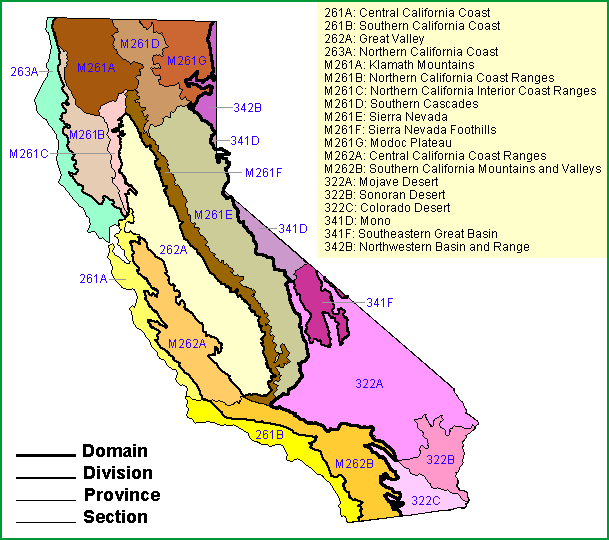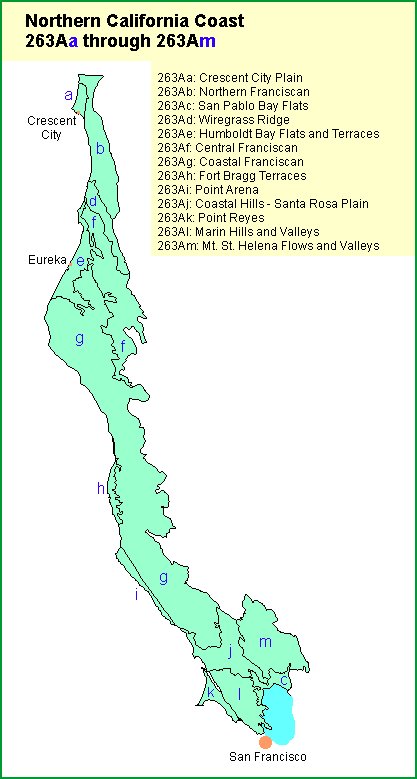 | Northern California Coast |
|
|
http://www.fs.fed.us/r5/projects/ecoregions/263a.htm
This section encompasses mountains, hills, valleys, and plains in the northern California Coast Ranges and small parts of the Klamath mountains that are close enough to the Pacific Ocean for the climate to be modified greatly by marine influence. Summers are characterized by fog, cool temperatures, and higher humidity than that inland. It is in MLRAs 4, 5, 14, and 15.
Geomorphology. Parallel ranges, folded, faulted and metamorphosed strata; rounded crests of subequal height. Coast Ranges Geomorphic province.
Lithology. Late Mesozoic eugeosynclinal rocks of the Franciscan Formation, and shelf and slope sedimentary rocks.
Soil Taxa. Alfisols, Inceptisols, Mollisols, Spodosols (Pygmy Forest), Ultisols and Vertisols in combination with isomesic, mesic or thermic soil temperature regimes, and aquic, udic, ustic or xeric (moist end of range) soil moisture regimes.
Vegetation. Predominant potential natural communities include the Redwood series, Douglas-fir - tanoak series, Oregon white oak series, Purple needlegrass series, Tanoak series and Coast live oak series.
The following series are found throughout the section and are not restricted to, or extensive in any subsection. Series dominated by exotic plants are not listed under subsections unless they are extensive and stable.
Series dominated by exotic plants: Broom series, Giant reed series, Cheatgrass series, Eucalyptus series, Iceplant series, Kentucky bluegrass series, Pampas grass series and Yellow bush lupine series north of Sonoma County.
Series that can occur in all subsections, but are not extensive: Bulrush series, Bulrush - cattail series, Burreed series, California oatgrass, Cattail series, Common reed series, Creeping ryegrass series, Duckweed series, Fen habitat, Idaho fescue series, Mosquito fern series, One-sided bluegrass series, Pondweeds with floating leaves series, Pondweeds with submerged leaves series, Sedge series, Spikerush series, Tufted hairgrass series and Yellow pond-lily series.
Series dominated by willows restricted to riparian settings: Arroyo willow series, Hooker willow series, Mixed willow series, Narrowleaf willow series, Pacific willow series, Red willow series, Sandbar willow series and Sitka willow series.
Disturbance series of short-lived vegetation: Blue blossom series, Coyote bush series away from the coast, Deerbrush series, Eastwood manzanita series, Red alder series away from the coast, Tobacco brush series and Wedgeleaf ceanothus series.
Fauna. Mammals include Roosevelt elk, black-tailed deer, black bear, mountain lion, coyote, bobcat, raccoon, skunks, marten, fisher and river otter. Birds include eagles, hawks, owls, peregrine falcon, osprey and a variety shorebirds and waterfowl along the coastal part of the section. Species of concern include marbled murrelet and northern spotted owl. Streams and rivers are used by anadromous fish.
Elevation. Sea level to 3,000 feet.
Precipitation. 20 to 120 inches.
Temperature. 40░ to 60░F. Summer daytime temperatures often modified by fog and sea breezes.
Growing Season. 225 to 310 days.
Surface Water Characteristics. Many slow or relatively slow streams and rivers in alluvial and weak bedrock channels flowing directly to the Pacific Ocean. Most terminate in tide affected brackish estuaries.
Disturbance Regimes.
Fire: Historic occurrence is changing from frequent, low to high intensity surface fires to infrequent, moderate to high intensity stand replacing fires.
Seismic Activity: Seismically active area with strong shaking and ground rupture.
Flooding: Periodic flooding occurs along major drainages. Landslides initiated by climatic, seismic and human events are common in steep areas of the section.
Land Use. Composition and successional sequence of some communities (primarily grassland communities) has changed because of plant and animal species introduced between the early 1800Æs and early 1900Æs related to grazing and forestry. The southern part of the section, and some of the northern part contains expanding urban areas.
Cultural Ecology. Humans have been utilizing the area for some 8,000 to 10,000 years, and have been an integral part of north coast ecology for some 2,000 to 3,000 years, thriving on the diversity of habitats from ocean and estuary to forest, and intensively gathering numerous resources. The variety of Northwest California ethnographic cultures is the most complex in the United States, reflecting diverse prehistoric and historic uses, practices, and human adaptations. The fur trade was a unique part of northwest coast early history, and later lumbering and agriculture were the main economy. Contemporary attitudes and beliefs are dichotomized between emphasis on amenity/newcomer and commodity/long-time resident values, but all overlain by a rural lifestyle, even in the trendy Marin headlands north of San Francisco. The economy is diverse, ranging from San Francisco Bay Area financial and entertainment industries to rural agriculture, forestry and fishing; tourism and recreation are important industries.
Subsections. The Northern California Coast section is divided into 13 subsections

